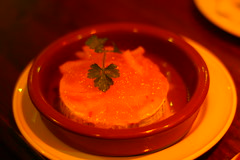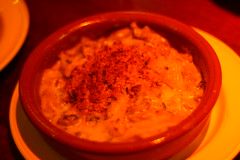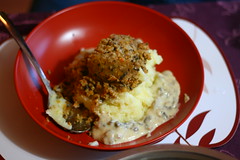Life has shifted here somewhat, with the (wishful) coming of spring. We’ve begun cycling indoors on our trainers (the term is over so I don’t have to go to the University that often), I’m working a part-time job, and our taste has turned more to things which are fresher, faster, and easier to prepare. So, the soup season has officially ended for the year, and we’re entering the sandwich season.
Because the vast majority of our cooking tends to be done in the manner of “oh, that’s really good, what did we put in it?” we’re trying to make more of an effort to document things.
 |
 |
 |
 |
 |
 |
 |
 |
The measurements won’t be quite right, as there were no measurements done in the first place, but they’ll at least approximate what we think we put in things. Truthfully, though, we’re pretty good at estimating quantities, so you should be OK.
Both of these recipes only take about 10-15 minutes to come together, which is an added bonus.
This first one could use any product, really, but we’re using Quorn because it’s what we had on hand. It could just as easily be made using Quorn Fillets, for example, or any chicken-style burger product.
Mock Chicken Sandwiches
- 1 Quorn Family Roast, baked according to packet instructions, cooled, chopped.
- 5 stalks Celery, chopped
- 2 spring onions, chopped
- 1/2 ‘brick’ Silken Tofu (firmness doesn’t matter)
- 2 Tbsp Mustard of your choice (we prefer spicy)
- 3 slices sweet pickled cucumber
- 1 Tbsp Salted Capers (leave the salt on)
- 2 Tbsp Tomato Ketchup
- 1 Tbsp Soy Sauce
- 2 Tbsp Yogurt
- Add Family Roast, Celery, Onions to bowl.
- Add everything else to separate bowl & puree using your immersion blender.
- Mix resulting sauce with your roast, celery, and onions.
- Serve on toast, Ryvita, whatever makes you happy.
This next one was this evening’s dinner, and is something that we’ll be repeating soon! Oh, my! Do NOT leave out the spices – not even the Chipotle powder!
 |
 |
Moroccan-Inspired Pita Sandwiches
For Filling:
- 1 ‘brick’ NON-silken style Tofu, cut to 1cm cubes
- 1 small Onion, diced fine
- 1 cup leftover Rice
- 1/4 cup Dried Cranberries
- 20 Cumin seeds, ground (approx 1/2 tsp)
- 1 tsp Chipotle powder
- 2 Tbsp roasted Pumpkin Seeds
- 2 Tbsp Sunflower Seeds
- Nutmeg (20 passes on the microplane)
- Cinnamon (likewise, but maybe more)
For Dressing:
- 3 Tbsp Olive Oil
- 5 Tbsp Balsamic Vinegar
- 1/2 ‘brick’ Silken Tofu (again, firmness doesn’t matter)
- 2 Tbsp Bitter-Orange Marmelade
- 1 Tbsp Mustard (again, hot is good)
- 1 Tbsp Salted Capers, salt on
To assemble the filling:
- Spritz hot frying pan with olive oil & add tofu, pushing it to the center of the pan (or wherever’s hottest in your pan).
- Add diced onion around the outside of pan.
- When tofu has browned on one side, turn it (perfect doesn’t matter here, just getting it unstuck from the pan).
- Sprinkle on spices & continue to sautee gently until onions are slightly changed in color.
- Add rice and seeds, remove from heat, and cover.
- Assemble your dressing.
To assemble the dressing: Blend it.
While washing & chopping lettuce, lay a few slices of pita bread on top of your filling, to warm while you’re otherwise occupied.
Cut pita bread, fill with some lettuce, some filling, and some dressing.
Eat!




































